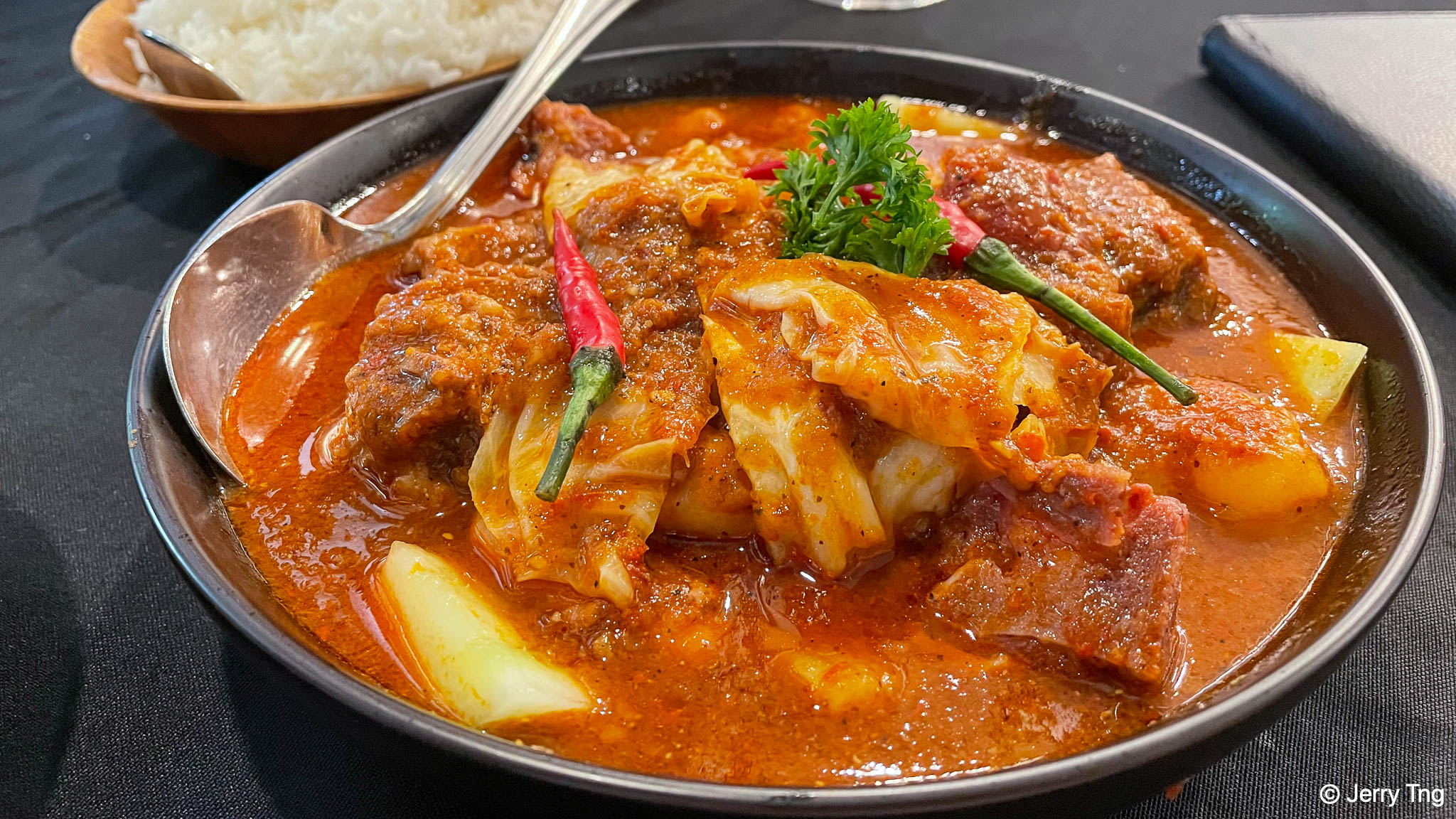In Singapore you have local Chinese, Malay, Indian and Peranakan cuisines with their ethnic roots to the respective races. And there’s the Eurasian cuisine that is often mistaken with Peranakan. So what is Eurasian cuisine?

To understand Eurasian cuisine, you have to understand a bit of the Eurasian lineage in Singapore. Many would think that it is a simple marriage of English and Asian people, but it is more than that. Before the British East India Company made Singapore an outpost, the Portuguese and Dutch were already active in these waters along the Straits of Malacca and in the Indonesian archipelago. And with that rich heritage comes a cuisine that is a potpourri of flavours and techniques.

The Eurasians grew up from its own cuisine from a wide expanse of cultural influences, the rich history which has transpired throughout Asia. However these days, you can many find the roots among the Portuguese, Indian, Kristang, Macanese (Cantonese-Portugese) and Peranakan to boot.
Prawn Bostador
Bostador is actually Creole Portuguese for ‘slap’, as in the first mouthful of this dish and you’re going to feel like you’ve been slapped by its fiery heat! Creole Portuguese, known as Kristao (pronounced Kristang) locally in Singapore, is a type of Portuguese spoken by the Eurasian population in Singapore and Malaysia of Portuguese descent.

This Eurasian dish has its roots in Portuguese Malacca and is very much Malay influenced in the spices used. Quentin’s Prawn Bostador is a thick coconut based-dish of large tiger prawns cooked in a luscious union of sliced green chillies and a blend of fresh local herbs. While it did not give you the tight ‘slap’ (we have asked the chef to go easy with the spices), it was complex with many flavours. The key characteristic is the used of green chillies instead of the reds which resulted in a sharper curry.
Curry Debal Oxtail
The word ‘debal’ in Curry Debal refers to ‘leftovers’ in the Kristang language. This spicy dish was created when all the leftover Christmas meats were put together in a hot curry, flavoured with candlenuts, galangal and vinegar. Over the years, ‘debal’ came to be heard as ‘devil’ and thus this dish is commonly known as ‘Devil Curry’, perhaps also symbolizing the spiciness of the curry.

Curry Debal Oxtail is made with a base of chilli, onion, ginger and blended mustard seed, and enhanced with bacon bones, chicken cocktails, potatoes, cabbage and cucumber. To luxe the combination, fork tender oxtail is added to the delicious “curry”. You have to eat this course with lots of rice, the sauce would make you chomp down an unbelievable amount of rice.
Patchri

Patchri are eggplants are halved, scored, marinated with pepper and salt, and then fried to perfection. The soul of the dish was Quentin’s special tamarind, sugar, onions and ginger sauce that was smoother on the eggplant in abundance with aromatics.

The first trio of dishes were quickly devoured with lots of steamed rice. The sauces were varied, from the spicy debal, to the sharp bostador to the tangy patchri. We had to order a second helping of rice to go with these dishes.
Roasted Pork Belly

The pork belly was marinated with spices and blended herbs and then placed inside the oven for slow roast. The pork was crunchy and hasda crackling skin with a juicy meat that was bursting with flavour. Served with a pickled cabbage, pickled carrots and their specially made chilli chuka, my guest commented that the roasted pork belly tasted like the Cantonese pork belly roast.
Dry Mee Siam

It is this kind of choices that got Quentin’s in a bad rap for being Peranakan. It was a nice dry mee siam, and they also offer the dry laksa a la Violet Oon. But it was kind of out of place in a Eurasian restaurant. But I would protest. Eurasian cuisine is an adventure and an accommodation of different cultures, therefore it would be perfectly ok to find the Cantonese influenced roasted pork belly or this Peranakan-based dry mee siam.
Sugee Cake

This is a cake that you will find in every Eurasian wedding. Sugee cake is simply a moist and comforting homemade cake using butter, almonds and semolina flour, topped with marzipan and laced with icing sugar and sprinkled with roasted almonds. Crumply like a muffin but sweet like a Viennese almond cake, the sugee cake is definitely local with the nutty flavour.
Putugal

Putugals are Eurasian steamed rice cakes made with tapioca, shredded coconut, pisang Rajah, butterfly pea flower and pandan extract. At first glance you would have mistaken it with the Malay kueh ubi kayu, but as you bite into one, the caramelised banana in the rice cake made the differentiation.
Whether or not you have tried Eurasian cuisine, I would recommend for you to come for the homely feeling and an excellent meal.
About Quentin’s

“Skinny Chef” Quentin learned the art of Eurasian Cooking from his Grandparents. He has taken the bold step of setting up a Eurasian Restaurant knowing full that Eurasian Family cooks will be his harshest critics. Quentin’s Eurasian Restaurant is the leader in continuing to offer these now rare Eurasian dishes to a hungry Singapore and is universally acclaimed as offering some of the most delicious food in the City, Eurasian or otherwise.
Quentin’s Eurasian Restaurant
139 Ceylon Rd, Level 1 Eurasian Community House, Singapore 429744
Tel : 6348 0327
Date Visited : May 2021

Pingback: The Little Nonya – live2makan
Pingback: Where Have You Been, 2021? – live2makan